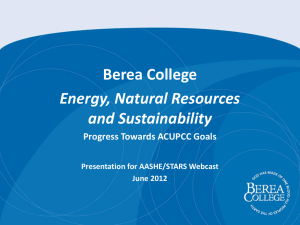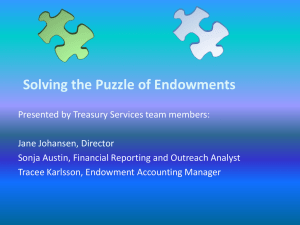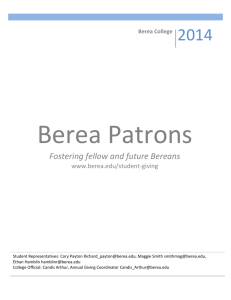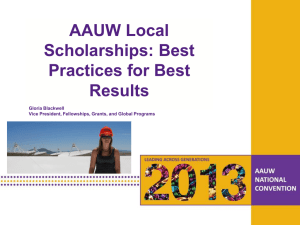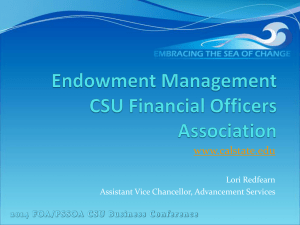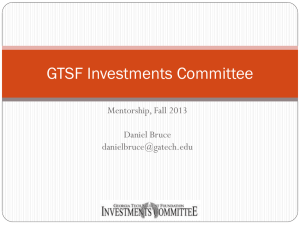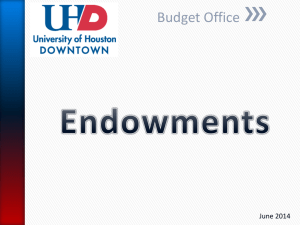Analysis of Ethical Investing at Berea College-1
advertisement
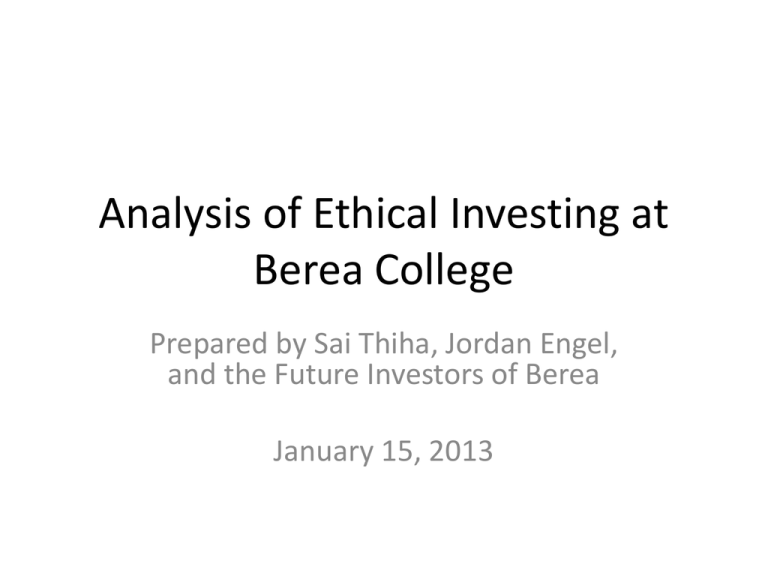
Analysis of Ethical Investing at Berea College Prepared by Sai Thiha, Jordan Engel, and the Future Investors of Berea January 15, 2013 The Future Investors of Berea • Since 1920, all unrestricted bequests have been placed into the College’s endowment Goals of Ethical Investing • Invest our endowment in ethical firms and institutions which offer the same rate of return as our current investments. • Use our endowment to support the Great Commitments and our Christian values. • Balance the key elements of social values, environmental values and financial returns. • Use policies and four key ethical investment methods with the consideration of diversifying risks. Berea’s Mission • From the Great Commitments: • “To serve the Appalachian region primarily through education but also by other appropriate services.” • “…work toward both personal goals and a vision of a world shaped by Christian values, such as the power of love over hate, human dignity and equality, and peace with justice.” • From Berea’s official Investment Policy [2006]: • “The investment of Berea’s endowment should be made with sensitivity to these Great Commitments, the ethical values they embody, and the significant dependence of the operating budget on endowment income.” Introduction to Endowments • Endowments are colleges saving account and earns returns from investments. • The return from investments go back to endowments and general operating accounts • Endowment performance is evaluated using benchmarks or pre-established goals. Berea’s Endowment • 80% of the College’s operations budget is funded by income from the endowment • Unlike many colleges and universities, Berea’s endowment is the centerpiece of the funding strategy for its educational mission of learning, labor and service. In a real sense, Berea’s endowment is its “tuition replacement fund.” Consequently, Berea’s investment strategy must promote both real growth and acceptable levels of risk if the College is to maintain its no tuition policy.” Berea’s Endowment (cont.) • Rate of Return: Berea’s earnings target is about 0.5% above the growth rate of the S&P500 over the last 3 decades. • The investment policy has been strategically developed to earn an acceptable rate of return over the long term with a moderate level of associated risk. Berea’s Endowment (cont.) Berea’s Endowment (cont.) Berea’s Endowment (cont.) • Transparency - 76% of the endowment is in funds that are publically viewable within the office of the VP of Finance. • Stocks included: Berea’s Endowment (cont.) Berea’s Endowment (cont.) Relevant Basics of Finance • Invest in a range of asset classes in order to minimize investment risk and maximize investment returns • Diversify risks- low risk low return, high risk high return • Hedging to prevent from complete loss • Holding different kinds of assets in case one asset or group of assets underperforms Basics of Finance (cont.) • Education endowments returned an average of 19.2% in FY2011 Basics of Finance (cont.) Conventional Investment for Typical Assets • • • • Cash – large corporate banks Bonds – suggest by investment consultants Stocks – mutual funds Assets and Real Estate – buy building around campus • Private Equity – invest in private equity firms • Hedge Funds – without transparency in term of social impact • Venture Capital – invest in companies with the best growth potential Ethical Investment for Typical Assets • Cash – community investment • Bonds – community investment • Stocks – shareholder advocacy, impact investing, positive screening, negative screening, divestment • Assets and Real Estate – invest in sustainable assets and real estate • Private Equity – negative screening • Hedge Funds – fund manager engagement, screening • Venture Capital – impact investing, positive screening Four Methods of Ethical Investment • • • • Divestment/Negative Screening Shareholder Advocacy Positive Screening/Impact Investing Community Investment Divestment • Investors exclude some stocks, bonds or investment funds that are unethical or morally ambiguous from their portfolio by negatively screening their funds. • Successful past college divestment campaigns include Darfur, Tobacco and South African Apartheid. • 155 campuses—including Berea—had divested from companies doing business in South Africa. • “The divestment movement played a key role in helping liberate South Africa. The corporations understood the logics of money even when they weren’t swayed by the dictates of morality,” – Archbishop Desmond Tutu Divestment (cont.) • The top 500 or so college endowments hold nearly $400 billion Divestment (cont.) • The “Filthy 15” are some of the largest, dirtiest coal companies in the U.S. These companies are destroying our Appalachian communities, and are fast-becoming an increasingly risky investment. Shareholder Advocacy • Investors take an active role as the owners of corporate America. • Frequently involves filing, and co-filing shareholder resolutions on social issues which are then presented for a vote to all owners of a corporation. • Shareholder engagement does not involve any changes in investments, therefore, it does not impact endowment investment returns. Shareholder Advocacy (cont.) • Faculty/Student Shareholder Responsibility Committees exist at many colleges. The committee does the research, writes the recommendations, and only leaves a small time commitment is required by the Trustees. • The committee at Williams has been empowered to vote on behalf of the college. As a result, at Williams board involvement consists of a single 15-minute agenda item at the May trustee meeting where the committee presents its annual report. Shareholder Advocacy (cont.) Positive Screening • Socially Responsible Investing (SRI) is a broad-based approach to investing that now encompasses an estimated $3.74 trillion out of $33.3 trillion in the U.S. investment marketplace today. • SRI recognizes that corporate responsibility and societal concerns are valid parts of investment decisions. SRI considers both the investor's financial needs and an investment’s impact on society. Creating positive social change while maintaining a standard or exceptional financial returns Positive Screening (cont.) Positive Screening • Socially Responsible Investment (SRI) has grown rapidly Positive Screening (cont.) • Portfolio 21 - fund invested in companies designing ecologically superior products, using renewable energy, and developing efficient production methods. Community Investment • Community Investing directs capital from investors and lenders to communities that are underserved by traditional financial services institutions. • Potential to inject capital into Appalachia as an investment strategy that remedies economic disparity by providing lower-income people access to capital, credit, and training that they otherwise would not have. • Community investing, however, is beyond charity and is a sound investment practice. These investments earn competitive returns, like non-community development investments, but also produce a social return that is attractive to investors and helps communities in need. Community Investment (cont.) • In 2012, a total of 1,043 community development financial institutions (CDFIs), including community development banks, credit unions, loan funds, venture capital funds, and microenterprise loan funds collectively managed $61.4 billion. Community Investment (cont.) • “The best investments aren’t in the Dow, they’re in Appalachia.” College Successes in Ethical Investing Guiding Questions • What do the students want? How can that happen? • What do trustees and the administration want? How can that happen? Our Recommendations 1. That Berea College appoint a permanent Ethical Investment Committee within the shared governance structure of the College with at least two student members. 2. That the President and VP of Finance advocate this cause to the Board of Trustees Investment Committee. 3. That Berea College continues to increase endowment transparency. 4. That Berea College invests 1% of the endowment in an Appalachian Community Development Fund 5. That the administration assess the interest of students in adding an investment class to the curriculum that would manage and impact investment fund.
